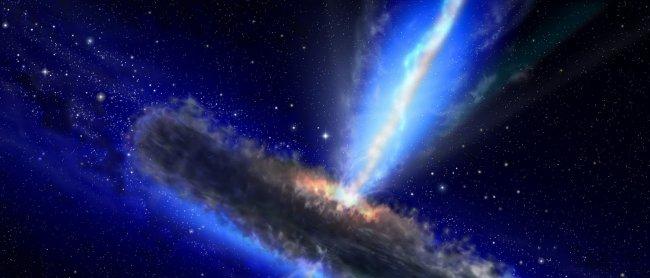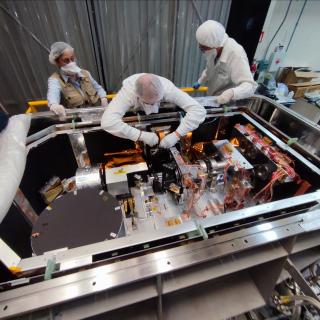An international team of scientists, with the IAC taking part, has been able to determine the structure of the galaxy FBQS J1644+2619 which has a powerful active galactic nucleus (AGN) at its centre. Two very energetic jets are being emitted by this nucleus. The study was made with the infrared camera CIRCE on the Gran Telescopio CANARIAS (GTC), at the Roque de Los Muchachos Observatory (Garafía, La Palma). This finding is relevant to the debate about the types of galaxies which can harbour the most powerful AGN’s, usually found in very massive elliptical galaxies. This is the first article to be published (in Monthly Notices of the Royal Astronomical Society) based on data from CIRCE.
An active galaxy has a nucleus containing a compact object, a supermassive black hole which swallows material from its surroundings, transforming it into luminous energy and in jets of highly energetic particles with velocities close to the velocity of light (“relativistic jets”). When one of these jets points towards the Earth its strong radio emission is highly amplified by relativistic effects, “blinding” us to the light from the host galaxy. This characteristic defines a class of AGN’s called “blazars”. In spite of their being subjects of research for decades, many aspects of their physics are still difficult to understand. Their formation, their structure, and the mechanisms for accelerating their particles, are among the unresolved questions of modern astrophysics.
Among the different types of AGN are the Seyfert nuclei, which are normally found in spiral galaxies, and do not usually have relativistic jets. Seyfert galaxies are classified according to their emission in visible light, into two types: 1, those whose nuclei are more luminous and emit spectral lines which are very broad coming from highly ionized gas, and 2, those with less luminous nuclei which do not present these broad emission lines. There are in fact intermediate types such as those termed narrow-line Seyfert 1’s, (NLSy1) which show peculiar characteristics; they are normally found in spiral galaxies, and the masses of their black holes are not greater than a few tens of millions of times the mass of the sun. In the last decade NASA’s Fermi satellite has detected gamma ray emission which varies with time emitted by some of these NLSy1’s, indicating a possible third class of AGN’s capable of producing relativistic jets even from relatively low mass central black holes.
Galaxies with active nuclei
“In which type of galaxies are galactic nuclei found?” Usually Seyfert nuclei are found in spiral galaxies and the masses of their central black holes are relatively small, (between one million and a few tens of millions of solar masses) while the very luminous jets had been observed only in giant elliptical galaxies, whose black holes are between a hundred million and several thousand million solar masses.
Finding jets in a class of AGN which are normally in spiral galaxies throw doubts on the model hitherto accepted by the scientific community, in which AGN’s produce jets only in giant elliptical galaxies. This discovery seems to imply that in the NLSy1’s the jets can be produced by mechanisms which differ from those in the blazars and radiogalaxies.
Infrared observations
To shed light on this subject, Filippo D’Ammando, a researcher at the Institute of Radioastronomy of the University of Bologna, together with the scientific team which includes the IAC researchers José A. Acosta-Pulido among others, used high resolution infrared images of FBQS J1644 + 2619, one of the Seyfert galaxies previously detected in gamma rays by the Fermi satellite. The galaxy FBQS J1644 + 2619 is not particularly luminous in the visible range, but it is very powerful at radio and gamma ray wavelengths. “This result” says Cristina Ramos Almeida, “was possible thanks to the excellent optics of the GTC, which let us take high contrast images, to separate the light from the galaxy from that emitted by the AGN. “Thanks to the data from CIRCE” explains José Acosta Pulido “we have been able to derive its surface brightness in order to see whether it has elliptical or spiral morphology, and we could estimate the mass of its central black hole”.
“We have shown for the first time that the host galaxy of an AGN of type NLSy1 is an elliptical galaxy, and that the mass of its central black hole is some 200 million solar masses, comparable with those which we normally find in blazars” notes Filippo D’Ammando.
This finding is important for testing theories of the nature of relativistic jets in AGN, although to elucidate their formation mechanisms it will be necessary to make further observations of the galaxies in which they are foun. “We don’t know why a sub-population of NLSy1 nuclei can develop in an elliptical galaxy and not in a spiral, as occurs for other types of active nuclei. This peculiarity seems to be fundamental for the formaito of the relativistic jets in these objects, and therefore for the gamma rays we observe with Fermi” concludes Filippo D’Ammando.
Artículo: “Uncovering the host galaxy of the γ-ray emitting narrow-line Seyfert 1 galaxy FBQS J1644+2619”, by F. D’Ammando et. al.
Mon Not R Astron Soc Lett slx042
https://academic.oup.com/mnrasl/article-lookup/doi/10.1093/mnrasl/slx042
Contact:
- José A. Acosta-Pulido: jap [at] iac.es (jap[at]iac[dot]es) and +34922 605 434
- Cristina Ramos Almeida: cra [at] iac.es (cra[at]iac[dot]es) and +34922 605 552




